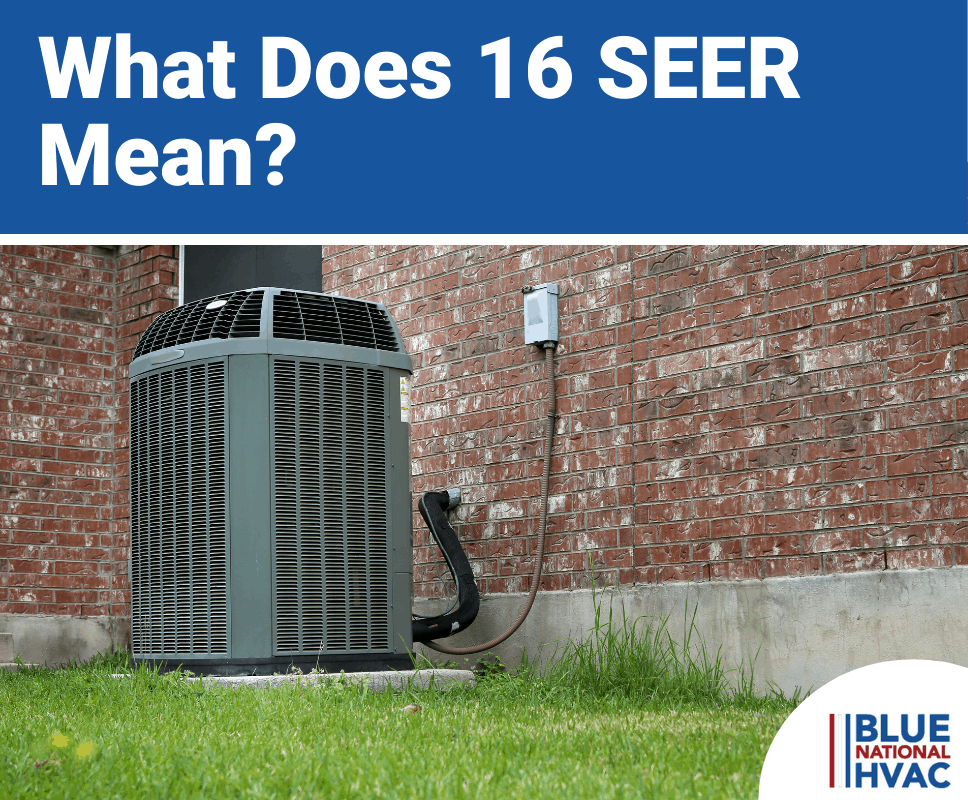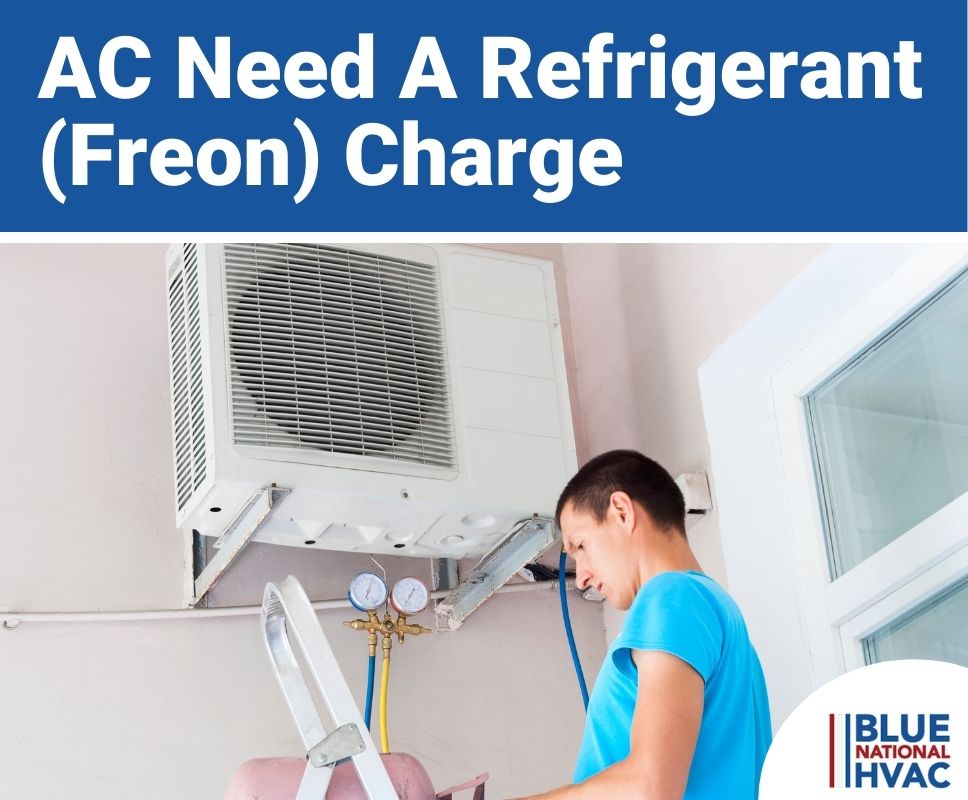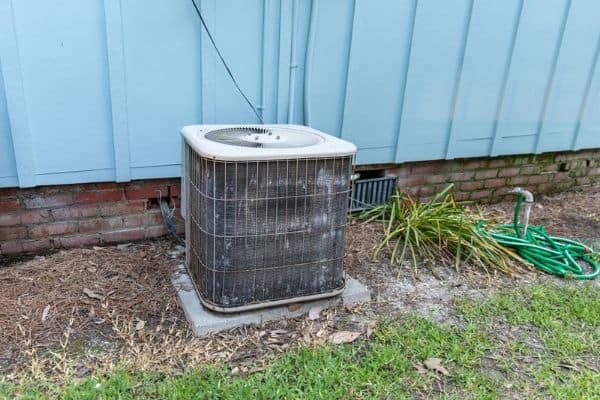What Exactly Does SEER Mean in Air Conditioners?
SEER is the Seasonal Energy Efficiency Ratio of air conditioning systems. In basic terms, it represents the efficiency of an air conditioner throughout the warmer months of the year.
An air conditioner with a higher SEER rating has better efficiency than one with a lower rating. To elaborate further, a 14 SEER AC unit is not as efficient as a 16 SEER unit.
If the 14 and 16 SEER units are rated at the same cooling capacity, then the 14 SEER air conditioner will use up more energy to cool your home. Additionally, it will result in a higher electricity bill compared to the 16 SEER air conditioner.
Every new AC unit is given a SEER rating (or comparable energy efficiency rating) as a way to compare air conditioners of different brands and types. This is especially useful for homeowners looking to replace their air conditioning system.
What Does 16 SEER Mean Exactly?
An air conditioner with a 16 SEER rating has a “16” ratio of its total cooling output over the electrical energy used throughout the whole cooling season.
The numerical ratio (16) is determined both mathematically and through testing and verification by the air conditioner manufacturer.
Air conditioning systems with 16 SEER ratings generally have both variable speed compressors and variable speed blowers.
These components provide better efficiency and more energy savings than lower SEER units which use single-stage or two-stage compressors and blowers.
So Is 16 a Good SEER Rating?
Air conditioning systems with 16 SEER ratings are considered good and are highly efficient. However, they are not the most efficient units on the market.
16 SEER air conditioners have a great value – they are generally lower costs than higher SEER AC units but provide more electricity cost savings than air conditioners with lower ratings like a 14 SEER unit.
Therefore, 16 SEER air conditioners give homeowners great value through their affordable upfront cost and electric bill savings.
How Do You Find the SEER Rating of an Air Conditioner?
The SEER rating of new air conditioning units can easily be found on the Energy Star – Energy Guide tag. The Energy Guide tag or label also provides a breakdown of the air conditioner’s efficiency and estimated annual cost.
Alternatively, you can also find the SEER rating on a new AC unit’s product or packaging label.
To find the SEER rating of an air conditioner you already own, you might need to do a bit more digging. The SEER rating might be stated on the air conditioner’s nameplate or instruction manual.
If you can’t find the SEER rating in either of those places, you should be able to find the model number and manufacturer. With that information, you can search for the air conditioner’s SEER rating online or call the manufacturer.
Why Is Air Conditioner Size & Capacity Important?
If you are browsing for new air conditioners online or looking for one in a store, you shouldn’t just base your decision on the SEER rating alone. You should also consider the size of the air conditioning system.
No, not the physical size! “Sizes” of air conditioners refer to their cooling capacities. An AC unit’s cooling capacity is the total amount of cooling an air conditioner can provide to your home.
You can estimate the correct sized air conditioner for your home using the square footage of your house. However, if you want the best approximation, you (or one of our HVAC contractors) should do a Manual J calculation.
The Manual J calculation takes many factors into consideration, the home’s size, the layout, amount of windows (and type), the amount of insulation, natural shade, and more.
If you choose an air conditioner that is too small for your home, it will not provide adequate home cooling. It will likely run constantly and never reach the setpoint on the thermostat, especially on hot days.
However, if the size is too large, it will provide too much cooling to your home too fast. When air conditioners provide too much cooling capacity, this leads to cold spots or hot spots in the house and the unit will have a tough time providing even cooling.
As you can see, having a properly sized air conditioner provides thorough and even cooling to your home and operates with the best efficiency possible.
Why are SEER Ratings Important?
The importance of SEER ratings is primarily due to government regulation and energy efficiency.
In 1987, the US established a minimum SEER rating of 10 for new air conditioners that took effect in 1992. Before that, the US had no requirements for minimum SEER ratings of air conditioners.
In 2005, the US Department of Energy (DOE) increased the minimum SEER rating to 13 and in 2015 upped the minimum SEER to 14 for just the southern US states.
Since SEER 13 and 14 are the minimum SEER ratings in the US, you won’t find any new air conditioners with ratings less than this on the market.
The US DOE has implemented an increase to the minimum SEER ratings taking effect in 2023. The minimum SEER ratings will increase to 14 SEER for the northern states and 15 SEER for the southern US states.
Finding Annual Energy Costs of 16 SEER AC Units
Calculating the estimated annual energy costs of a 16 SEER air conditioner is easy – it just requires a calculator and some simple math. You’ll need to know your local electricity costs and the cooling output of your AC unit.
Before we get to the calculations, let’s establish some hypothetical values first:
- SEER rating: 16 SEER
- Cooling output: 6,400 BTU/h
- Electricity rate: $0.27 per kilowatt-hour (kWh)
- The AC unit will be used 125 days per year
- The air conditioner will be one for 10 hours each day
Note: The SEER rating and the cooling output are specifications of your air conditioner and can be found on the product label or manual. You can find your electricity rate on your energy bills.
Okay, now let’s get to the math. The first thing we need to do is figure out the cost per hour to run the air conditioner. To do that, we need to find the power usage in kilowatts:
6,400 BTU/h 16 SEER = 400 watts or 0.4 kilowatts (kW)
Next, we calculate the cost per hour by multiplying the power usage by the electricity rate:
0.4 kW$0.27 per kWh =$0.108 per hour
Lastly, to calculate the annual electricity cost in this hypothetical example, you multiply the cost per hour by the number of days used per year and the number of hours used per day.
125 days 10 hours per day $0.108 = $135.00 per year
There you have it – the annual cost per year is $135 to run this air conditioning system! This cost is just an estimate. You probably won’t use your air conditioner for the exact number of days or hours you used in this equation.
However, this gets you into the ballpark, and likely won’t differ from your estimate by more than $10.00.
16 SEER Annual Cost Vs. Other SEER Ratings
Since a 16 SEER air conditioner looks like it is relatively inexpensive to operate, how do the annual electricity costs compare to lower SEER and higher SEER units? Well, it is actually not much given that these costs are spread throughout an entire year.
Here’s how they compare, assuming we use the same cooling output, usage per year, and electricity rate we used in the 16 SEER calculation:
- 14 SEER Annual Cost: $154.29
- 16 SEER Annual Cost: $135.00
- 18 SEER Annual Cost: $120.00
- 20 SEER Annual Cost: $108.00
- 22 SEER Annual Cost: $98.18
SEER is Not All About Cost
Air conditioners with higher SEER numbers are designed to run for lower periods of time instead of starting and stopping often, like low SEER AC units.
Running lower versus starting and stopping is actually more energy-efficient, contrary to what you might think. It takes a considerable amount of energy to quick an AC unit on compared to it running.
Additionally, higher SEER air conditioners provide finer setpoint control (i.e., they match the value on the thermostat better) with their variable-speed compressors and blowers.
Because higher SEER air conditioners run longer, they provide more even, consistent cooling to your home.
This reduces the number of hot spots and cold spots in the house so if you currently have rooms that seem much warmer than others, you may benefit from a higher SEER AC unit (and maybe a larger sized unit too).
SEER Vs. EER and COP Energy Efficiency Ratings
Along with SEER ratings, there are two other energy efficiency ratings that are just as valuable when it comes to selecting an air conditioning unit. They are EER and COP:
- EER: Energy Efficiency Ratio
- COP: Coefficient of Performance
Compared to SEER, the efficiency measure throughout the entire cooling season, EER is the energy efficiency at a single time and a single outdoor temperature –- 95°F (35°C). Similar to SEER, the higher the EER number, the more efficient the AC unit is.
Generally, SEER can be converted to EER by multiplying SEER by 0.875. The 0.875 conversion is just an approximation and is not technically a “true” conversion since EER and SEER are calculated at different temperatures and different spans of time.
COP is a term that is mainly applied to heat pumps, although air conditioners do have COP measurements too. COP is an indication of the efficiency of the conversion of electricity to heat in a heat pump. Heat pumps provide both heating and cooling to your home.
Just like SEER and EER, a larger COP number indicates better efficiency.
Energy Star Energy Guide Tags
The Energy Guide tag, created through the Energy Star program, is a yellow tag that shows the SEER, EER, COP, and sometimes all three ratios for an air conditioning system. The Energy Guide tag also provides an estimated cost per year to operate the AC unit.
Energy Star is an energy efficiency program mutually run by the US Department of Energy and the Environmental Protection Agency (EPA).
Energy Star provides energy consumption information not just on air conditioners but almost every electronic device that plugs into a wall.
What Types of AC Units Have 16 SEER Ratings?
Almost all types of air conditioners are available with a 16 SEER rating. 16 is not an unusually high SEER rating, so it is pretty standard and achievable with every kind of AC system on the market.
As such, you will be able to find 16 SEER air conditioners on the market easily and, if you choose to, have one installed in your home.
Central Air Conditioners
Central air conditioners connect to the ductwork in your home and provide air conditioning to every room connected to the ductwork. Because of this, they are one of the most convenient ways to cool your home.
16 SEER central air conditioners are one of the most common types of units found in homes these days. However, you can still find units from 13 to 20+ SEER on the market.
The maximum SEER rating for central air systems is in the low to mid-30s. However, because of air pressure and temperature losses in ductwork, the “true” or measured SEER rating could be up to 20% lower in a real-world application.
Window AC Units
Window air conditioners typically have an EER rating on their Energy Guide tag and usually don’t show a SEER rating.
In general, you can find window AC units with 11.5 to 14 EER, which roughly approximates to 13 to 16 SEER. Therefore, if you want a window AC unit that is 16 SEER, you should choose a unit with an EER rating of 14.
Air-Source Heat Pumps
Air-source heat pumps are like central AC systems. However, they can also provide heat to your home! Air-source heat pumps are essentially air conditioners that can run the vapor-compression refrigeration cycle in reverse to heat your home.
Air-source heat pumps have the same available SEER ratings as central AC systems – 13 to 20+ SEER. Air-source heat pumps with a 16 SEER rating are relatively common and are an excellent option for your home.
Ductless Mini-Split Heat Pumps
Ductless mini-split heat pumps range in available SEER ratings from 14 to 30+ SEER. In fact, ductless mini-split systems have the largest SEER rating possible!
For example, Carrier – a popular furnace and AC system manufacturer – invented a ductless mini-split air conditioner capable of 42 SEER!
For ductless mini-split heat pumps, 16 SEER is considered a low rating since they can easily achieve much higher SEER ratings.
Ductless mini-split systems can achieve such high SEER ratings mostly because they experience no losses in the ductwork. They add cool air directly to the room, and they have separate evaporator and compressor units.
How Much Does a 16 SEER Air Conditioner Cost?
Air conditioning units with a 16 SEER rating are generally fairly affordable systems. Plus, they do not cost significantly more than 13-15 SEER air conditioning units, and they provide more even cooling while yielding slightly lower energy costs.
Compared to higher SEER AC units (17+), 16 SEER is a more cost-effective option upfront and does not have a substantial annual energy cost differential. So, keep these factors in mind if you decide to get a 16 SEER air conditioning system.
Central Air Conditioners 16 SEER Cost
Central air conditioner’s pricing varies based on two main factors, size (in BTUs or tons) and SEER ratings. With that in mind, let’s compare the average prices on various size AC units with a 16 SEER rating:
- 1.5 ton (18,000 BTU): $900
- 2 ton (24,000 BTU): $1,200
- 2.5 ton (30,000 BTU): $1,700
- 3 ton (36,000 BTU): $1,950
- 4 ton (48,000 BTU): $2,600
- 5 ton (60,000 BTU): $3,100
Ductless Mini-Split Heat Pump 16 SEER Cost
Ductless mini-split heat pump prices vary by size and SEER rating, and the amount of “zones” they are required to cool. These zones are basically the h
Typically you can have four evaporator units that mount on the wall or ceilings of the zones and one condenser that sits outside.
As an example, a 30,000 BTU (2.5 ton) ductless mini-split system with four zones runs $3,000 to $4,000 on average.
When Should You Hire A Professional To Choose a SEER Rating and AC Unit?
Determining if a 16 SEER air conditioner is the right choice for your home may be too much work if you’re not well versed in AC units and the nuances of heating and cooling your home.
Beyond SEER ratings, there are other factors like air conditioner size, brand, and type that can make it even more challenging for you to choose the proper unit for your home.
If you are finding the decision on an AC unit to be too complicated, you should consult with one of our HVAC professionals to determine the best fit for your home.
Air Conditioner Sizing and HVAC System Recommendation
Our HVAC specialists can help provide recommendations on the type of AC system that will be best for your home (central, ductless mini-split, etc.), and along with that, they can guide you toward the best SEER rating for your needs.
Additionally, they can perform a Manual J calculation to determine the correct air conditioner size for your home.
Our HVAC technician can also propose various brands and options while comparing the costs and leave the final decisions up to you. Consulting a pro will save you valuable time and be a helpful hand throughout the process.









